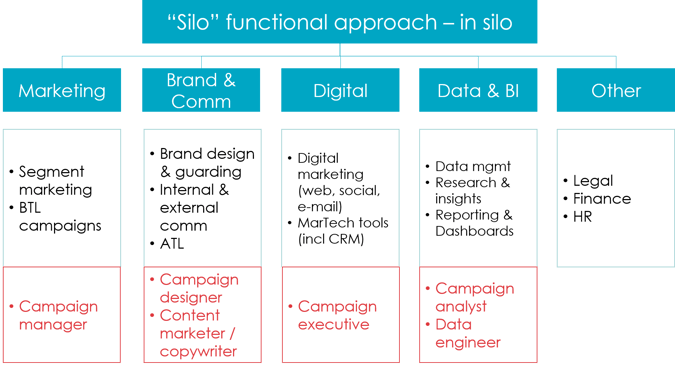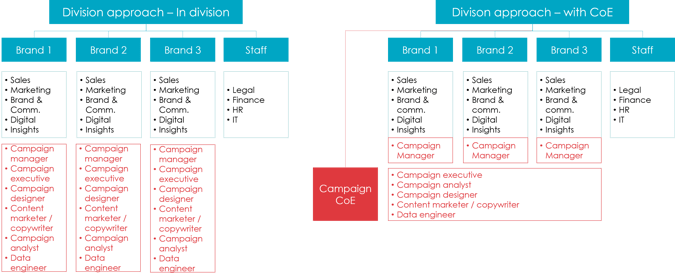In this second article of our series on marketing automation challenges, we focus on the team you need when opting for the new, automated way of campaigning. First, we look at the required roles for the set-up of your marketing automation tool and the roll-out of campaigns. We then dive into the integration of those roles into your organization, before moving on to the number of resources you need.
Which roles do you need for marketing automation?
The answer to this question is double: you will need more roles in the “build” phase (setting up the tool) than in the “run” phase (using the tool). A role, however, doesn’t necessarily equal a full-time equivalent (FTE). You could combine roles into one FTE or assign a role to a person as a part of his current job. For the “build” phase, you need the following roles:
The more business (and thus marketing) roles:
- The marketing automation leader inspires the whole company to embrace marketing automation, is the owner of the business needs and plays a key role in the change process.
- The campaign manager decides which campaign and flows are needed to achieve the company’s objectives. To do so, he needs to interact with the marketing team. He also creates personas and draws customer journey maps.
- The campaign executive makes sure that the campaigns, flows, e-mails and landing pages are correctly implemented in the marketing automation tool.
- The campaign designer provides creative support to the campaign manager and executive. He ensures the look, feel and user experience (UX) are crystal clear and meet the brand guidelines. He creates HTML templates and style sheets and sets up a digital assets database. In that way the marketing team can create campaigns with a simple drag and drop.
- The content marketer creates the right content for your flows and campaigns to convert your prospect into a customer.
- The copywriter makes sure all texts are well structured and written in the right tone of voice.
- The campaign analyst assures that campaign owners and the management receive the right reports and dashboards to evaluate the success and KPIs of the campaigns. He also conducts an in-depth analysis if needed.
The more technical roles:
- The system architect makes sure the system is future-proof and works well. He verifies all tools are well interconnected.
- The project manager (and possible program manager for more complex implementations) ensures teams are well aligned and the project runs smoothly, respecting the agreed timing, budget, needs and requirements. He also takes care of tests and validations by the business.
- The lead developer, possibly assisted by other front-end, back-end or full stack developers, codes common features.
- Data engineers, also known as database marketers, create data selections in the marketing automation tool that are needed for targeting, customization and personalization.
Regarding the “run” phase, once everything has been set up properly, the marketing team can run its campaigns without a campaign designer and a campaign analyst. On the technical level, data engineers will probably still need to make new data available – and from time to time a (front-end) developer might come in handy.
Where do these roles fit into my organization?
Performing automated marketing goes hand in hand with a significant change in the marketing team’s way of working. As previously described, it requires quite some new roles, both during the “build” and the “run” phase. We will further focus on the “run” phase, as the “build” stage will be tackled by project teams.
How will you organize your teams, so they can work in the most effective and efficient way possible? Although you may end up with a totally new organization, it’s best to start from your current organizational model. There are hundreds of different models possible. We will focus on 2 extreme approaches to prove our point: the divisional approach and the “silo” functional approach.
When your business can be considered as a “silo” functional organization, with separate functional groups, we recommend you to add your marketing automation resources to the functional groups where the most similar profiles are. For example, if the marketing group is already conducting offline campaigns, the (digital) campaign manager matches best with the members of that group. The table below shows where to integrate marketing automation profiles in your organization.

If your business is located at the other end of the spectrum, we talk about the divisional approach. When the company is organized in self-supporting business units or brands, there are 2 options: either you add extra resources to each division or you combine them in one Center of Excellence (CoE) for marketing automation. A CoE enables centralized knowledge building and sharing. The table below depicts both options.

Numerous variations are possible depending on your current organization. But the most important decision is whether you want to cluster the marketing automation expertise in a Center of Excellence or add some marketing automation expertise in every entity. According to Econsultancy, the digital maturity level is a good guidance to define the best option for your organization. If your company’s digital maturity level is rather low, you better opt for the Center of Excellence approach. If you already have a good digital knowledge level within your organization, you can opt for the in division model (also known as the hub-and-spoke mode at Econsultancy).
How many extra resources do you need?
This is the most difficult question and it’s impossible to give a generic answer. Let’s try anyway, because it’s a frequently returning question. As a rule of thumb, we’ll give the number of campaigns you can roll out per FTE per month. The definition of campaign is an automated flow using multiple marketing channels, so not just a plain e-mail.
A full-time campaign manager can create 3 or 4 new flows per month. You’ll need 1 campaign executive per 2 campaign managers. For support, about 10% to 15% of a FTE of a campaign designer, content marketer, copywriter, campaign analyst and data engineer are needed.
Just like an individual customer, each company is unique and requires a tailor-made approach for the set-up of your marketing automation team, your organizational model and the number of FTEs. If you have a burning question about these topics, don’t hesitate to reach out.
Want to tackle more marketing automation challenges?
Which profiles should you gather for marketing automation? What if you're only using marketing automation to send out emails? Which approach helps you to avoid sending too many emails to the same recipients? How can you improve the use of your tool by prioritizing features?
Sign up for our complete article series and learn how to overcome 4 other common marketing automation hurdles.





